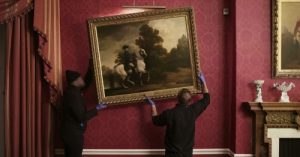Room with a View: Considering the work of Amie Siegel
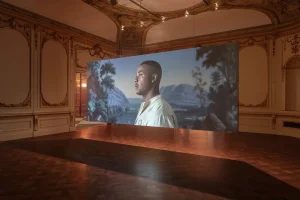
Amie Siegel, Vues/Views, 2024. 4K video, color/sound (recto); found hand-blocked wallpaper, paint (verso) © Amie Siegel. Courtesy Thomas Dane Gallery. Photo: Elliot Goldstein/Smithsonian Institution
NB: Today’s post was written by Home Subjects co-editor Anne Nellis Richter and includes long excerpts from a recent review of Amie Siegel’s Vues/Views for The Brooklyn Rail. The review was written by Meredith Martin. These excerpts have been used with her permission.
Brooklyn-based artist Amie Siegel has spent a substantial part of her career making work that intersects compellingly with our interests here at Home Subjects. This year, Siegel’s installation Vues/Views was featured at the Smithsonian Design Triennial at the Cooper Hewitt in New York which ran from November 2, 2024 through August 10, 2025. The theme of the Triennial, “Making Home”, was intended to highlight “design’s role in shaping the physical and emotional realities of home across the United States, US Territories, and Tribal Nations.” I saw Vues/Views in late January, and have been thinking about it ever since. It is as graceful an example as one can find of deep scholarship communicated through (almost) purely visual language. While the film uses little to no audible dialogue, sound permeates its atmosphere. Ambient noises–the ticking of clocks, the rustle of strong breezes, the polishing of silverware–are used to great effect, lulling the viewer into an affinity for the pleasing aesthetics of these long-preserved yet lived in interior spaces. Late in the film, as humans begin to disrupt the interior and exterior landscapes Siegel has carefully laid out before us, instruments and the human voice provide a counterpoint to the film’s early stillness to bracing and unsettling effect. We’d like to take this opportunity to highlight a few of Siegel’s other recent installations, which use the film medium to train her contemplative, penetrating cinematic eye on the decorative aspects of interiors and the people (and animals) that inhabit them, with results that explore relationships between domestic interiors and the arts that adorn them and reveal underlying structures of class, power, and privilege.
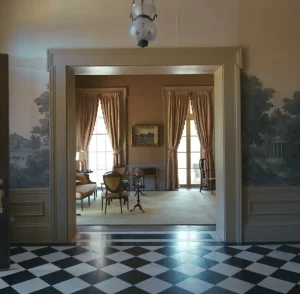
Amie Siegel, Vues/Views, 2024. 4K video, color/sound (recto, still) © Amie Siegel. Courtesy Thomas Dane Gallery
Vues/Views uses the elite American interior, with a particular focus on French scenic wallpapers, as a lens through which to explore race. Siegel’s film features a number of gracious houses situated in rural and urban landscapes up and down the East coast of the United States, most of which are still private residences and all of which contain well-preserved examples of French scenic wallpapers installed in the nineteenth or early twentieth century. These wallpapers interact with the rooms in which they are installed, the landscapes in which those buildings sit, and the people who lived in and maintained them, collapsing the distinction between past and present. Vues/Views is projected onto a screen suspended in one of the Cooper Hewitt’s elegant ground floor spaces, the back of which Siegel has covered with scraps of a Zuber wallpaper series titled Les vues d’Amérique du Nord (1834). This wallpaper is just one of several Zuber papers featured in the film; others depict real and imaginary sites including El Dorado, Hindustan and Brazil.
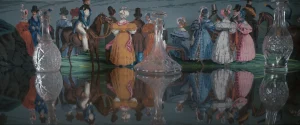
Amie Siegel, Vues/Views, 2024. 4K video, color/sound (recto, still) © Amie Siegel. Courtesy Thomas Dane Gallery
Writing in The Brooklyn Rail, Meredith Martin notes that Zuber, founded in 1797, “specialized in panoramic scenes depicting exotic, picturesque locales, often with a colonial or imperial subtext. These scenes…offered wealthy consumers the fantasy that they might bring the entire world to their doorsteps, while shutting them off from its violent realities—including, in the case of plantation landscapes, those that existed just beyond their walls.” It is Les vues d’Amérique du Nord to which Siegel devotes the most sustained attention; unlike the other wallpaper series’ mentioned above, Les vues directly addressed the mythologies of contemporary America in the period when it was first designed and being installed in elite residences. Martin writes: “Designed by the French artist Jean Julien Deltil, ‘Vues’ can still be printed for high-end clients using the original woodblocks, now classified as ‘historical monuments’ in France. The series portrays sweeping vistas of New York Bay, West Point, Boston Harbor, Niagara Falls, and Virginia’s Natural Bridge, and it offers a rose-colored vision of America during the Jacksonian era. By showing the proliferation of ‘Vues’ in a range of historic interiors and homes that continue to be inhabited today, Siegel explores how such panoramic scenes construct partial, one-sided myths about history and national identity whose political and racial inequities persist today. But she also asks us to think about how we choose to maintain these myths, and how we might break or remake them in the present. The paradoxes of Jacksonian democracy are on full display across the wallpaper scenes in Vues/Views. Crowds of people representing different classes, races, and genders gather to watch soldiers marching in formation, sailors unloading cargo, and Native Americans performing a dance. The panoramic landscape proposes a uniquely American vision of infinite possibility, but the portrayal of non-white people, as the historian Jasmine Nichole Cobb has noted, advances narrow-minded stereotypes taken from sources like Edward W. Clay’s Life in Philadelphia (1828–30), a series of racist caricatures that mocked the city’s free Black residents and their adoption of middle-class fashions and mores.”
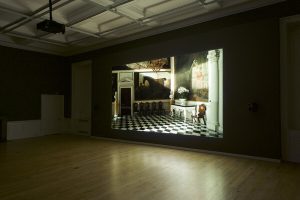
© Amie Siegel. Bloodlines, 2022. Courtesy of Thomas Dane Gallery. Photo: Isobel Lutz-Smith. National Galleries of Scotland. Commissioned and acquired with the support of Art Fund and Contemporary Art Society, with additional production support from Princess Grace Foundation, New York and PALOMAR, 2022
With Vues/Views Siegel is returning to themes she explored in previous works like Bloodlines, which premiered in 2022 and is now in the permanent collection of the National Galleries of Scotland. Where Vues/Views emphasizes aspects of social and racial indentity that are specific to the American context, Bloodlines considers the complex interrelationships between aristocracy, power and privilege in Britain, as expressed through the work of 18th century artist George Stubbs. Stubbs is known as a pre-eminent animal painter of the period, who turned his talents to depicting racehorses, hunting hounds and a variety of other creatures whose presence was key to the functioning of the country estate. Humans also appear in his pictures, sometimes as the owners of the animals they depict, and occasionally, as rural labor. Perhaps because so many of Stubbs’ pictures focus on human-animal relationships of various types, they can often still be found in the collections of the families who originally commissioned, them, as Siegel noted in a discussion of Bloodlines hosted by the National Gallery. The film begins by situating pictures in the milieu of the 21st century country house, then follows them as they are carefully crated and transported to a loan exhibition where their visual contexts and social meanings shift dramatically. In the film’s final third, the pictures travel back to their physical and metaphorical ‘homes’ in the private interior, with occasionally surprising results.
For readers in the UK, Bloodlines is being screened at the Goodwood Art Foundation in West Sussex through 2 November, 2025. In the National Gallery discussion linked above, Siegel drops hints about the films themes and interests; she also declares her preference that prospective audiences avoid spoilers, so none will be shared here. What I will say is that as its title suggests, Bloodlines is interested in how Stubbs’ pictures communicate family lineage and pedigree through portraits of animals and humans and what the careful preservation and display of these pictures in both public and private spaces has to say about the lineages they represent.Similar concerns underpin Vues/Views. Not long ago, Les vues d’Amérique du Nord would likely have been understood by many art historians as ‘decorative’ art, not fully embraced as a cutural artifact with deep lessons to communicate about either the society that produced it in the nineteenth century, or the one that continues to meticulously maintain it well into the twenty-first. Siegel’s film argues for the wallpaper itself as an animating force in the interior. Martin writes, “In Siegel’s film, we follow her suspenseful, slow-moving camera with a mounting sense of dread as she takes us on a tour of American interiors where this wallpaper still resides, accompanied by other luxury domestic goods (china, glassware, and silver), related paintings and sculptures of Founding Fathers and Native Americans, and signs of current habitation like family photographs and lounging dogs. The creepy sounds of ticking and chiming clocks, coupled with shots of cracked or decaying wallpaper, convey a sense of time passing but also folding in on itself. Apart from [the opening sequence filmed at The Hermitage in Nashville] it’s never made explicit exactly where we are, an effect that adds to the film’s uncanny vibe and its desire to weave together larger narratives about power and taste across the American landscape. We are, however, given clues that skew toward the rural South and the urban East Coast, among them copious Spanish moss and kudzu as well as metropolitan skylines with recognizable landmarks.”
“One scene depicts an antebellum Virginia plantation known as Eyre Hall, whose identity is divulged via shots of family archives that inventory its furnishings and other ‘property,’ including enslaved individuals. Another shows a former gentleman’s club known as the Pendennis Club in Louisville, Kentucky whose dining rooms are named after Zuber panoramas. The club’s motto, ‘Nec Tenui Penna,’ refers to the ‘unfailing wings’ on which its male members rose to the heights of power and wealth. The exploitation and exclusion that made their ascent possible is trenchantly underscored by Siegel’s footage of Black waiters and groundskeepers as well as women who carefully conserve the wallpaper and arrange furniture while the mostly offscreen male homeowners day trade and talk on the phone.”
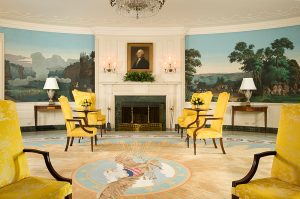
This circa 2009 photograph by Peter Vitale depicts the Diplomatic Reception Room of the White House. The French wallpaper in the Diplomatic Reception Room, depicting scenes of Boston, Niagara Falls, West Point, Natural Bridge, and New York Harbor, was installed under the direction of First Lady Jacqueline Kennedy in 1961. A circa 1805 painting of George Washington by Gilbert Stuart hangs above the mantel. Photo credit: Peter Vitale, c. 2009. © White House Historical Association
Martin rightly ends her review where Siegel’s film does: in the Diplomatic Reception Room of the White House in Washington D.C., where Jackie Kennedy oversaw the installation of Les vues d’Amérique du Nord in 1961. It is a stunning scene. I recommend reading Martin’s review in full, but she concludes by noting that while “Siegel made the film before last November’s election…it’s hard not to think about its conflation of past and present, memory and resistance, in light of recent political events….Are we trapped in this panoramic nightmare or can we change the view?”
